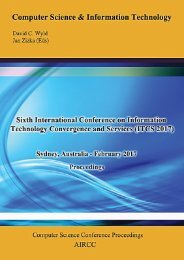CoSIT 2017
Fourth International Conference on Computer Science and Information Technology ( CoSIT 2017 ), Geneva, Switzerland - March 2017
Fourth International Conference on Computer Science and Information Technology ( CoSIT 2017 ), Geneva, Switzerland - March 2017
Create successful ePaper yourself
Turn your PDF publications into a flip-book with our unique Google optimized e-Paper software.
ESTIMATING HANDLING TIME OF<br />
SOFTWARE DEFECTS<br />
George Kour 1 , Shaul Strachan 2 and Raz Regev 2<br />
1 Hewlett Packard Labs, Guthwirth Park, Technion, Israel<br />
2 Hewlett Packard Enterprise, Yehud, Israel<br />
ABSTRACT<br />
The problem of accurately predicting handling time for software defects is of great practical<br />
importance. However, it is difficult to suggest a practical generic algorithm for such estimates,<br />
due in part to the limited information available when opening a defect and the lack of a uniform<br />
standard for defect structure. We suggest an algorithm to address these challenges that is<br />
implementable over different defect management tools. Our algorithm uses machine learning<br />
regression techniques to predict the handling time of defects based on past behaviour of similar<br />
defects. The algorithm relies only on a minimal set of assumptions about the structure of the<br />
input data. We show how an implementation of this algorithm predicts defect handling time with<br />
promising accuracy results.<br />
KEYWORDS<br />
Defects, Bug-fixing time, Effort estimation, Software maintenance, Defect prediction, Data<br />
mining<br />
1. INTRODUCTION<br />
It is estimated that between 50% and 80% of the total cost of a software system is spent on fixing<br />
defects [1]. Therefore, the ability to accurately estimate the time and effort needed to repair a<br />
defect has a profound effect on the reliability, quality and planning of products [2]. There are two<br />
methods commonly used to estimate the time needed to fix a defect, the first is manual analysis<br />
by a developer and the second is a simple averaging over previously resolved defects. However,<br />
while the first method does not scale well for a large number of defects and is subjective, the<br />
second method is inaccurate due to over-simplification.<br />
Application Lifecycle Management (ALM) tools are used to manage the lifecycle of application<br />
development. Our algorithm relies on a minimal number of implementation details specific to any<br />
tool and therefore has general relevance. Our implementation is based on the Hewlett Packard<br />
Enterprise (HPE) ALM tool. We tested the algorithm with projects from different verticals to<br />
verify its broad applicability.<br />
One of the advantages of our implementation is that it does not assume a standard data model, but<br />
is able to handle the cases where the defect fields available vary between different data sets. We<br />
Dhinaharan Nagamalai et al. (Eds) : <strong>CoSIT</strong>, SIGL, AIAPP, CYBI, CRIS, SEC, DMA - <strong>2017</strong><br />
pp. 127– 140, <strong>2017</strong>. © CS & IT-CSCP <strong>2017</strong><br />
DOI : 10.5121/csit.<strong>2017</strong>.70413





